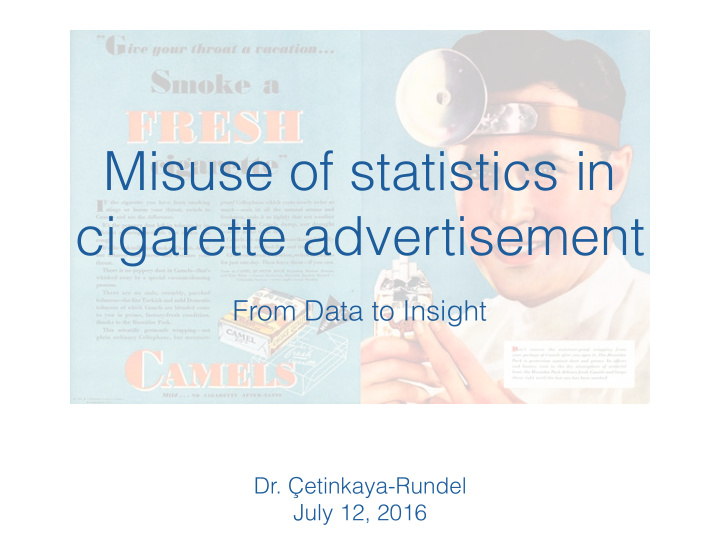



Misuse of statistics in cigarette advertisement From Data to Insight Dr. Çetinkaya-Rundel July 12, 2016
Recap ‣ Brandt: “there is no single gold standard of disease causality”. What is the reason behind this claim? ‣ Clinical observations, population studies, and laboratory experiments are thought to be the three distinct but related domains of medical knowledge. What can we conclude from each one regarding the relationship between smoking and lung cancer? How do they complement each other? ‣ How could you improve on Wynder & Graham’s and Doll & Hill’s studies/experiments? 2
Causal conundrum 3
In the 1950‘s, how did the cigarette companies respond to scientific findings showing a relationship between smoking and cancer? ‣ Denying the problem ‣ Produce and sustain scientific skepticism and controversy ‣ assert that the relationship between smoking and cancer is “not proven” ‣ pseudoscientific research showing some cigarettes are better than others ‣ Strong PR campaign emphasizing tobacco industry’s commitment to scientific research 4
Denial ‣ A medical specialist is making regular bi-monthly examinations of a group of people from various walks of life. 45 percent of this group have smoked Chesterfield for an average of over ten years. ‣ After ten months, the medical specialist reports that he observed… no adverse effects on the nose, throat and sinuses on the group from smoking Chesterfield. Arthur Godfrey 5
Pseudoscience ‣ Camel cigarettes 30-Day Mildness Test ‣ “The test was sensible” 6
PR Campaign ‣ Industry sponsored research entity ‣ call for new research implied that existing studies were inadequate or flawed ‣ there was “more to know” ‣ made the industry seem a committed participant in the scientific enterprise rather than the enemy ‣ Initiated collective research to demonstrate shared concern for the public instead of focusing on the health benefits of particular brands Tobacco Industry Research Committee (1953) 7
What was “The Frank Statement” (1953) intended to demonstrate? Tobacco industry is ‣ committed to public health, ‣ serious, authoritative and judicious ‣ eager to fulfill its responsibilities to the public 8
“Smoke without fear” (1954) ‣ If you are a man or a woman who smokes, relax and enjoy it. ‣ If you have tried to give up smoking a dozen times and failed, quit trying. 9
“See It Now” with Edward Murrow ‣ Two episodes on cigarettes and lung cancer ‣ Interview with Dr. Little who says that no cancer-causing agents in cigarettes have been identified and therefore a causal relationship cannot be established. Edward Murrow 10
“Another Frank Statement to Smokers” (1958) 11
12
What made Clarence Cook Little the perfect candidate for the scientific director of the TIRC? ‣ Established scientist who has been working on cancer research ‣ Believed that cancer resided in individual’s genetic linage ‣ Ultraconservative about cause and effect relationships 13
How did researchers’ opinion about smoking research evolve throughout the 1950’s? ‣ Most started with skepticism ‣ Prospective studies showing a link between smoking and increasing death rates from lung cancer convinced some researchers ‣ Abundance of studies showing a link between smoking and lung cancer made it difficult to ignore the possibility of a causal relationship entirely 14
“The Great Debate” (1961) It is enough to say that most of the evidence is statistical and demonstrates a close association between heavy cigarette smoking and lung cancer. However, it is generally believed that statistics in the hands of a master can be made to prove almost anything. 15
“The Great Debate” (1961) Each individual must choose his own course, whether to woo the lady nicotine or abjure the filthy weed, while the search for truth continues. 16
“Not One Single Case of Throat Irritation”: Misuse of the Image of the Otolaryngologist in Cigarette Advertising Samji & Jackler (2009) 17
Questions to consider for your writing ‣ What is the overall idea being presented in this paper? ‣ What is the main question (hypothesis) being posed in the paper? ‣ What methodology did the authors use to test their hypothesis? ‣ Does the conclusion agree with what the authors hypothesized? ‣ Does this article agree with previous readings? ‣ Do you agree with the author’s conclusions? 18
Throat specialists Pseudoscience
Medical authority Babies?
Creation of a manufacturing myth 21
Toasted
Fresh, not toasted
Freshness
Involvement of physicians on tobacco ads ‣ Why were they involved? ‣ There was not definitive and accepted literature linking cigarette smoking to illness. ‣ Prevalence of smoking among physicians was high. ‣ Other than false claims of safety, what other impact did the use of medical authority and imagery in tobacco advertising have? ‣ Lower likelihood of antismoking messages being communicated in private clinical settings. 25
Reader’s Digest “Cancer by the Carton” 1952 FTC banned Surgeon General’s references to report on smoking physicians and and its health medical terms effects from tobacco ads 1955 1964 1950 1958 1968 Wynder & Graham Gallup Poll: Gallup Poll: study published 44% of Americans 78% of Americans 1954 believe smoking believe smoking causes cancer causes cancer Doll & Hill study preliminary results published Hammond & Horn study published
Can you think of any other industry sponsored ads today? 27
“got milk?” (National Milk Processor Board)
High fructose corn syrup “Sweet Surprise” (Corn Refiners Association)
Recommend
More recommend